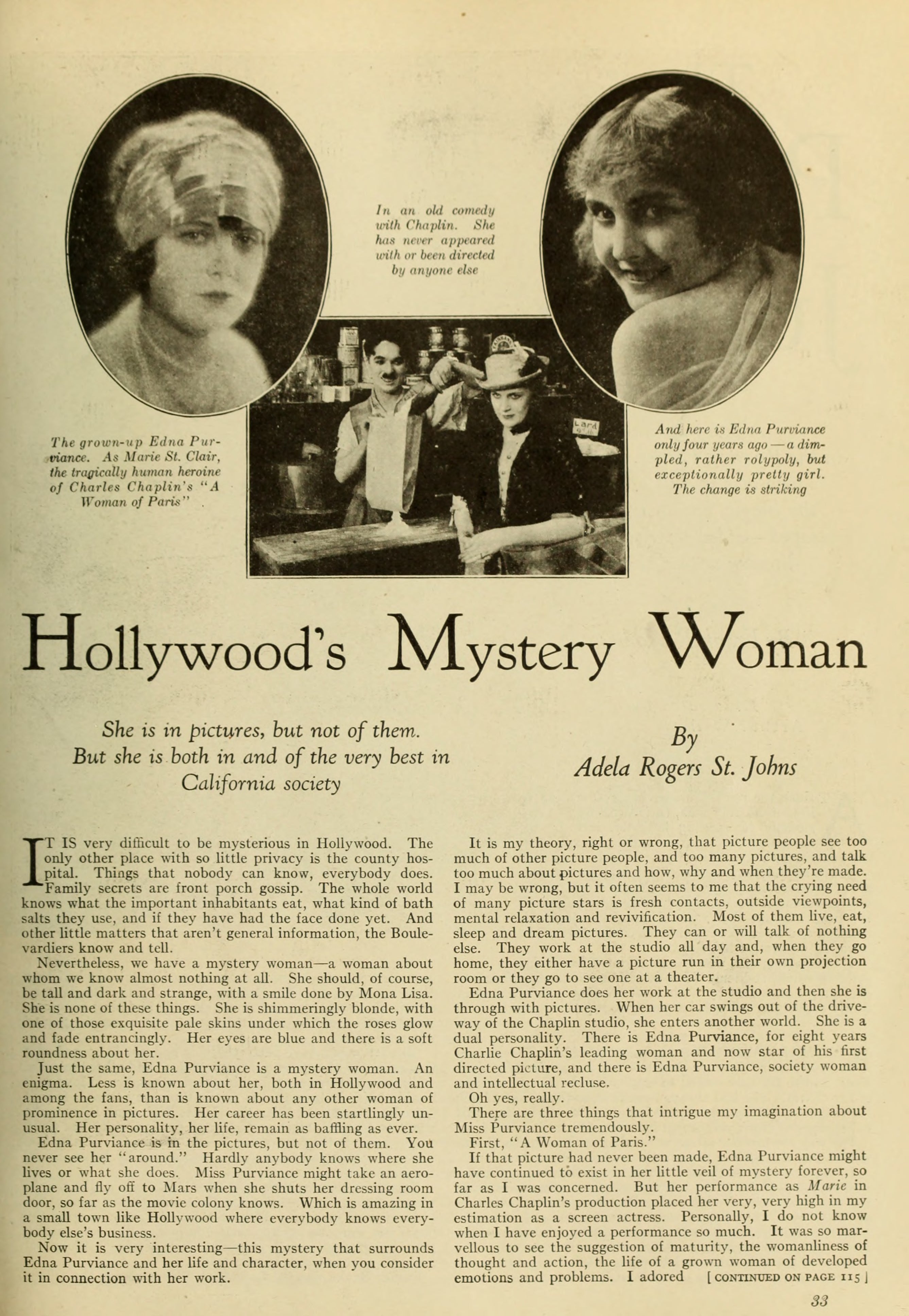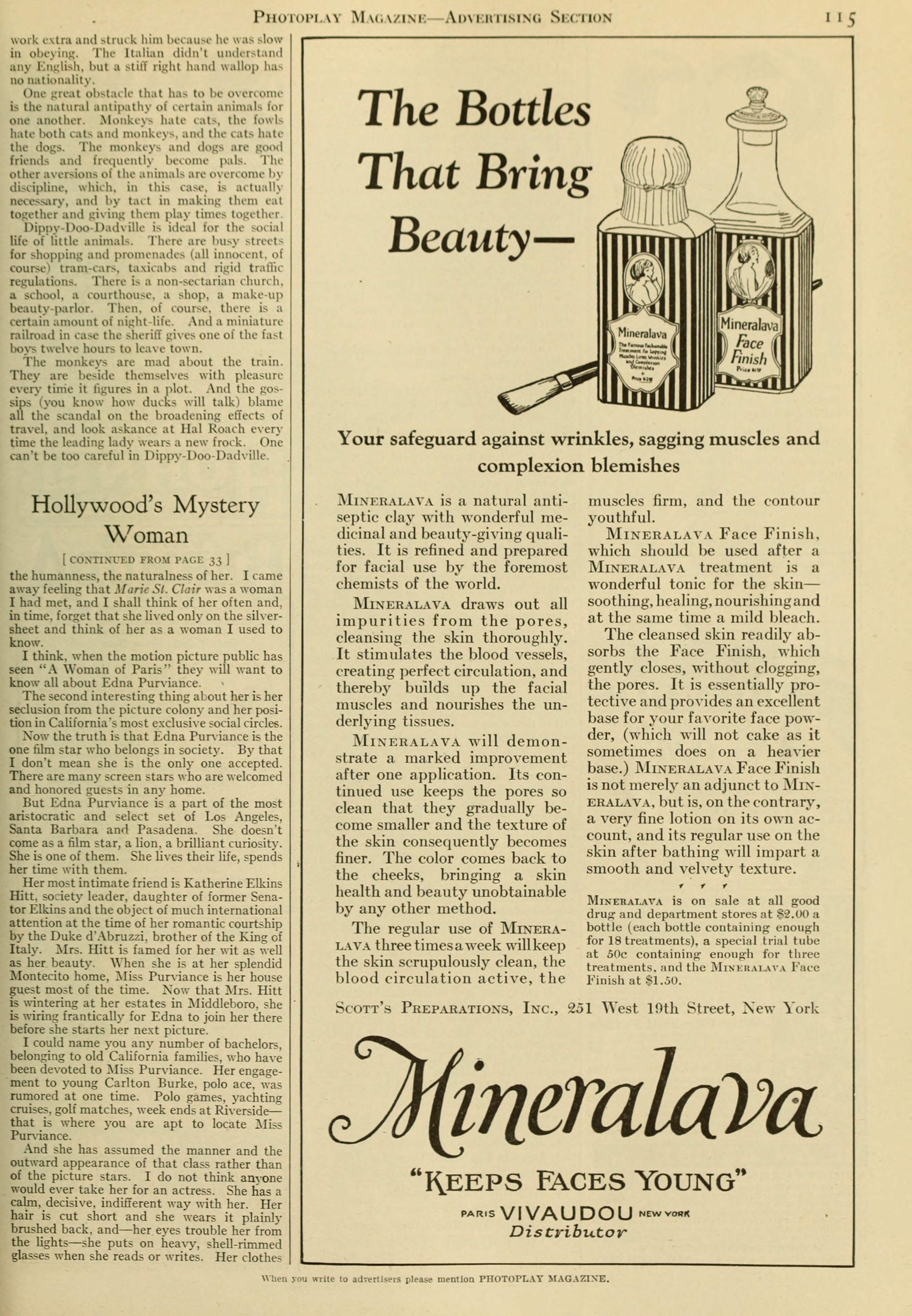Edna Purviance — Hollywood’s Mystery Woman (1924) 🇺🇸

It is very difficult to be mysterious in Hollywood. The only other place with so little privacy is the county hospital. Things that nobody can know, everybody does. Family secrets are front porch gossip. The whole world knows what the important inhabitants eat, what kind of bath salts they use, and if they have had the face done yet. And other little matters that aren’t general information, the Boulevardiers know and tell.
by Adela Rogers St. Johns
Nevertheless, we have a mystery woman — a woman about whom we know almost nothing at all. She should, of course, be tall and dark and strange, with a smile done by Mona Lisa. She is none of these things. She is shimmeringly blonde, with one of those exquisite pale skins under which the roses glow and fade entrancingly. Her eyes are blue and there is a soft roundness about her.
Just the same, Edna Purviance is a mystery woman. An enigma. Less is known about her, both in Hollywood and among the fans, than is known about any other woman of prominence in pictures. Her career has been startlingly unusual. Her personality, her life, remain as baffling as ever.
Edna Purviance is in the pictures, but not of them. You never see her “around.” Hardly anybody knows where she lives or what she does. Miss Purviance might take an aeroplane and fly off to Mars when she shuts her dressing room door, so far as the movie colony knows. Which is amazing in a small town like Hollywood where everybody knows everybody else’s business.
Now it is very interesting — this mystery that surrounds Edna Purviance and her life and character, when you consider it in connection with her work.
It is my theory, right or wrong, that picture people see too much of other picture people, and too many pictures, and talk too much about pictures and how, why and when they’re made. I may be wrong, but it often seems to me that the crying need of many picture stars is fresh contacts, outside viewpoints, mental relaxation and revivification. Most of them live, eat, sleep and dream pictures. They can or will talk of nothing else. They work at the studio all day and, when they go home, they either have a picture run in their own projection room or they go to see one at a theater.
Edna Purviance does her work at the studio and then she is through with pictures. When her car swings out of the driveway of the Chaplin studio, she enters another world. She is a dual personality. There is Edna Purviance, for eight years Charlie Chaplin’s leading woman and now star of his first directed picture, and there is Edna Purviance, society woman and intellectual recluse.
Oh yes, really.
There are three things that intrigue my imagination about Miss Purviance tremendously.
First, A Woman of Paris.
If that picture had never been made, Edna Purviance might have continued to exist in her little veil of mystery forever, so far as I was concerned. But her performance as Marie in Charles Chaplin’s production placed her very, very high in my estimation as a screen actress. Personally, I do not know when I have enjoyed a performance so much. It was so marvelous to see the suggestion of maturity, the womanliness of thought and action, the life of a grown woman of developed emotions and problems. I adored the humanness, the naturalness of her. I came away feeling that Marie St. Clair was a woman I had met, and I shall think of her often and, in time, forget that she lived only on the silversheet and think of her as a woman I used to know.
I think, when the motion picture public has seen A Woman of Paris they will want to know all about Edna Purviance.
The second interesting thing about her is her seclusion from the picture colony and her position in California’s most exclusive social circles.
Now, the truth is that Edna Purviance is the one film star who belongs in society. By that I don’t mean she is the only one accepted. There are many screen stars who are welcomed and honored guests in any home.
But Edna Purviance is a part of the most aristocratic and select set of Los Angeles, Santa Barbara and Pasadena. She doesn’t come as a film star, a lion, a brilliant curiosity. She is one of them. She lives their life, spends her time with them.
Her most intimate friend is Katherine Elkins Hitt, society leader, daughter of former Senator Elkins and the object of much international attention at the time of her romantic courtship by the Duke d’Abruzzi, brother of the King of Italy. Mrs. Hitt is famed for her wit as well as her beauty. When she is at her splendid Montecito home, Miss Purviance is her house guest most of the time. Now that Mrs. Hitt is wintering at her estates in Middleboro, she is wiring frantically for Edna to join her there before she starts her next picture.
I could name you any number of bachelors, belonging to old California families, who have been devoted to Miss Purviance. Her engagement to young Carlton Burke, polo ace, was rumored at one time. Polo games, yachting cruises, golf matches, week ends at Riverside — that is where you are apt to locate Miss Purviance.
And she has assumed the manner and the outward appearance of that class rather than of the picture stars. I do not think anyone would ever take her for an actress. She has a calm, decisive, indifferent way with her. Her hair is cut short and she wears it plainly brushed back, and — her eyes trouble her from the lights — she puts on heavy, shell-rimmed glasses when she reads or writes. Her clothes are quite simple. Her voice, particularly, is pleasing, low and round.
I had a dreadful time discovering where she lives. Yet it is one of the most attractive homes I have ever seen — back of the Wilshire Country Club. Her mother lives with her, and she has two married sisters, much older than herself, who visit her frequently.
Once in a while she spends an evening with Mabel Normand, an old friendship that survives from the early Sennett days.
The third thing is the friendship that exists, between her and Charlie Chaplin, and the strangeness of her professional career, which is largely a result of that friendship.
“Back in 1915, little Edna Purviance, just out of a Los Angeles finishing school, met Charlie Chaplin at a party where she had gone with one of her married sisters. They were terribly thrilled at meeting a real “movie actor.” Charlie took one look at the lovely, young blonde and said:
“Did you ever think of going into pictures?” Edna giggled. “I should say not,” she said, with her nose in the air.
It happened to be true that she had no desire to act. But she did want to see how a movie was made. So, when Mr. Chaplin asked her and her sister to come down to Niles, California, next day and see them work, she went. Ten minutes after her arrival. Charlie had a make-up on her. And she’s been his one and only leading woman ever since. She has never worked with anyone else, never been directed by anyone else. A circumstance that is without a parallel in pictures.
Several years ago a big dramatic part was offered her. Later, one of the big producers made her a starring offer. She refused them both. Charlie found out about it, and he said to her: “That’s right. You stick by me now while I need you, and some day I’ll make a dramatic star of you myself.”
A Woman of Paris is the result of that promise.
Years ago, when they first worked together, everyone expected them to marry. I don’t remember whether an engagement was ever announced, but certainly they were very much in love. But in those days, Edna was full of life, full of desire to see life. They had a quarrel, Edna dashed off to Honolulu with some friends, and, when she came back, Charlie was married to Mildred Harris.
Strangely enough, out of that youthful romance has grown a deep and wonderful friendship. Edna Purviance is Charlie Chaplin’s oldest and truest friend. Eor eight years they have been friends, the kind of friends who rejoice in that inner feeling of mutual trust and dependence and affection. Other women have come and gone in his life, but Edna is the only one who has remained — the only lasting feminine influence in his career, the only woman to whom lie has always been consistently devoted and to whom he has turned in his moments of trial.
She was born in Nevada, but she came to California when she was very young and it has been her home ever since.
“It isn’t true,” she said to me the other day, “that I’m not ambitious. But when I leave the studio — I leave pictures. I have to. Besides, in working with Charlie, there have been long spaces between pictures, and I have had to build my own life outside. I believe I’m happier. And I believe I can give more to my work, now that my big chance has come.”

—
The grown-up Edna Purviance. As Marie St. Clair, the tragically human heroine of Charles Chaplin’s A Woman of Paris.
In an old comedy with Chaplin. She has never appeared with or been directed by anyone else
And here is Edna Purviance only four years ago — a dimpled, rather rolypoly, but exceptionally pretty girl. The change is striking

—

—
The Seven Wonders of the Cinema
- Mary Pickford’s Hairdresser.
- Douglas Fairbanks’ [Douglas Fairbanks Sr.] Dentist.
- Gloria Swanson’s Dressmaker.
- Harold Lloyd’s Bonesetter,
- Charlie Chaplin’s Bootmaker.
- Rodolph Valentino’s [Rudolph Valentino] Press-agent.
- Cecil B. DeMille’s Property-man.
— Town Topics.
Every advertisement in Photoplay Magazine is guaranteed

—
Hollywood knows very little about Edna Purviance and calls her a woman of mystery. An enigma but — since her first starring nature in A Woman of Paris — conceded to be a great actress. Here is her latest portrait, which shows a charming maturity
Photo by: Edwin Bower Hesser (1893–1962)
Collection: Photoplay Magazine, February 1924
—
see also
